Pickleball Positioning: Mastering the Court for Strategic Success
Pickleball, a sport that marries the finesse of tennis with the accessibility of badminton, has surged in popularity over the years. As players flock to courts across the globe, mastering the art of pickleball positioning has become paramount in determining success on the court. Positioning in pickleball isn’t just about where you stand; it’s about understanding the dynamics of the game, anticipating your opponent’s moves, and seamlessly executing strategies that can turn the tide in your favor. Just like a well-orchestrated dance, the relationships between players, their movements, and the court’s layout play a crucial role in dictating the rhythm of play.
At its core, pickleball positioning is about optimizing your placement for both offense and defense. It requires a blend of strategy, awareness, and communication elements that elevate a player’s performance from merely competitive to exemplary. The nuances of court layout, key areas, and strategic positioning techniques are what we’ll explore in detail throughout this article. Whether you’re a novice just stepping onto the court or an advanced player looking to refine your skills, understanding the intricacies of positioning can enhance your gameplay, build your confidence, and maximize your potential on the pickleball court.
Understanding Pickleball Court Layout
To grasp the concept of pickleball positioning, one must first understand the basic layout of the courts. Typically, a pickleball court measures 20 feet in width and 44 feet in length, with clear demarcations that outline essential areas including the non-volley zone (or “kitchen”), the service areas, and the baselines. The net, standing 36 inches high at the sidelines and 34 inches high at the center, divides the court into two equal halves each tailored for competitive play.
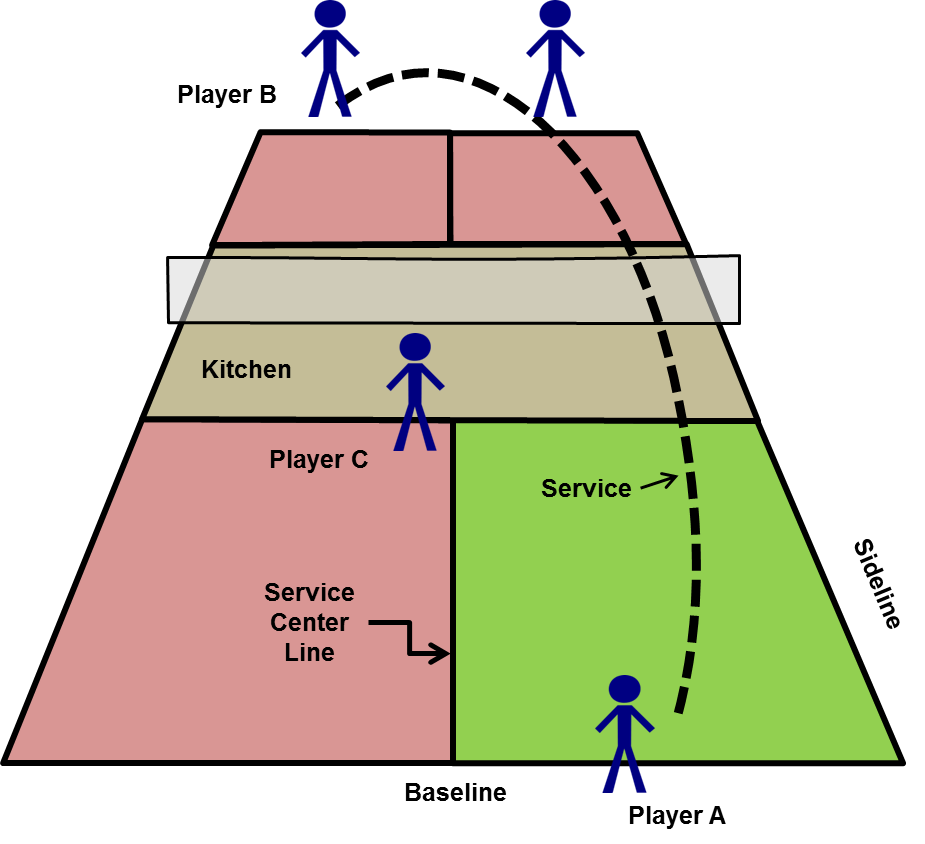
The court’s layout is punctuated by areas that are crucial for effective positioning. Each half of the court is comprised of service areas that extend 15 feet from the net. This serves as a framework for players to begin their rallies, establishing the rules of engagement. The non-volley zone, an integral region extending 7 feet from the net, adds a layer of strategy as players must grapple with the limitations it imposes. The baseline, located 22 feet from the net, and the sidelines, spanning 20 feet apart, define the boundaries of play, making the court an essential focal point in any match.
Understanding the court layout not only informs players of where to stand but also enhances their ability to visualize movement and anticipate shot placements. For players new to the sport, this foundational knowledge builds the first layer of strategic play, allowing them to construct effective gameplay based on the spatial dynamics presented by the court’s layout.
Key Areas of the Court
The significant areas of the pickleball court each serve unique functions that shape gameplay. Implementing effective court positioning requires an intimate knowledge of these key areas:
- The Non-Volley Zone (Kitchen): As previously mentioned, the kitchen is a 7-foot area extending from the net. Players cannot volley the ball while standing in this zone, which adds a unique strategic layer to the game. It requires players to master soft shots, or dinks, to play effectively in this area without violating the rules.
- Service Areas: The court’s service areas are crucial for initiating rallies. Players must serve the ball within these zones from behind the baseline. Proper positioning during serving can greatly impact the game’s tempo and flow.
- Baselines and Sidelines: These lines are the boundary markers of the court. Players must be mindful of these boundaries to avoid faults, and they also influence how players position themselves when moving forward or backward.
- Transition Zone: This area lies between the non-volley zone and the baseline. Mastering movement in this zone is key, as players transition between offensive and defensive roles during rallies.
Understanding these areas allows players to make informed decisions regarding their positioning, whether attacking the net or retreating to defend.
Dimensions and Markings
Having clear dimensions and markings on the court is essential for a fair and safe game.
- Overall Size: A regulation pickleball court measures 20 feet wide by 44 feet long, providing a total playing area of 880 square feet. This compact size allows for fast-paced play while encouraging quick reflexes and strategic positioning.
- Markings: High-quality, visible lines delineate the different zones, including the kitchen, service areas, and boundaries. These clear markings help players maintain awareness of their positioning both for foot placement and shot execution.
Proper court layout and markings not only enhance player safety but also support effective gameplay. Players who understand the markings can better position themselves for optimal shot placement, avoiding penalties for foot faults or positioning violations.
Importance of Each Zone
Each zone on the pickleball court plays a significant role in shaping gameplay strategies.
- The Non-Volley Zone (Kitchen): Mastering this area enables players to execute strategic soft shots and prevents opponents from taking volleys too comfortably. The kitchen serves as a tactical battleground where players must balance aggression with caution.
- Service Areas: The service areas allow players to set up their shots based on their strengths. A well-placed serve can dictate the tempo of the ensuing rally.
- Baselines: The baseline offers a safe retreat, enabling players to prepare for returns without overcommitting. This line serves as a defensive anchor, where players can regroup during rallies and reevaluate their positioning strategies.
- Transition Zone: Movement through this zone is critical for adaptability. Players must read the game accurately in this area, transitioning fluidly between offensive and defensive tactics.
Understanding the importance of each zone allows players to create effective strategies that leverage their strengths while countering their opponents’ tactics.
Visualizing Effective Movement
Effective movement on the pickleball court hinges on proper positioning relative to the layout and strategically interpreting the flow of gameplay. The visualization of movements starts with awareness of the zones and how they relate to your actions.
- Anticipating Shots: By visualizing where each shot will land based on both your actions and your opponent’s positioning you can move freely and efficiently across the court.
- Spatial Awareness: Players must maintain spatial awareness, always positioning themselves within range to respond to shots while being mindful of court boundaries.
- Dynamic Movement: Visualizing your movement each point helps maintain balance and prompt reactions. The fluidity of movement is like water flowing in a stream players must adapt to the terrain and flow of the game.
- Mastering Angles: Positioning yourself allows you to cover more angles on the court. By honing your visualization skills, you can react quickly and effectively during high-stakes moments.
Ultimately, effective movement and positioning invite a strategic depth that can turn an average player into a formidable competitor.
Basics of Court Positioning
To excel in pickleball, mastering the basics of court positioning is fundamental. This encompasses placements within critical areas, including the non-volley zone, baseline, and mid-court dynamics. Players must develop a tactical awareness of how they can position themselves to maximize their strengths while counteracting their opponents’ strategies.
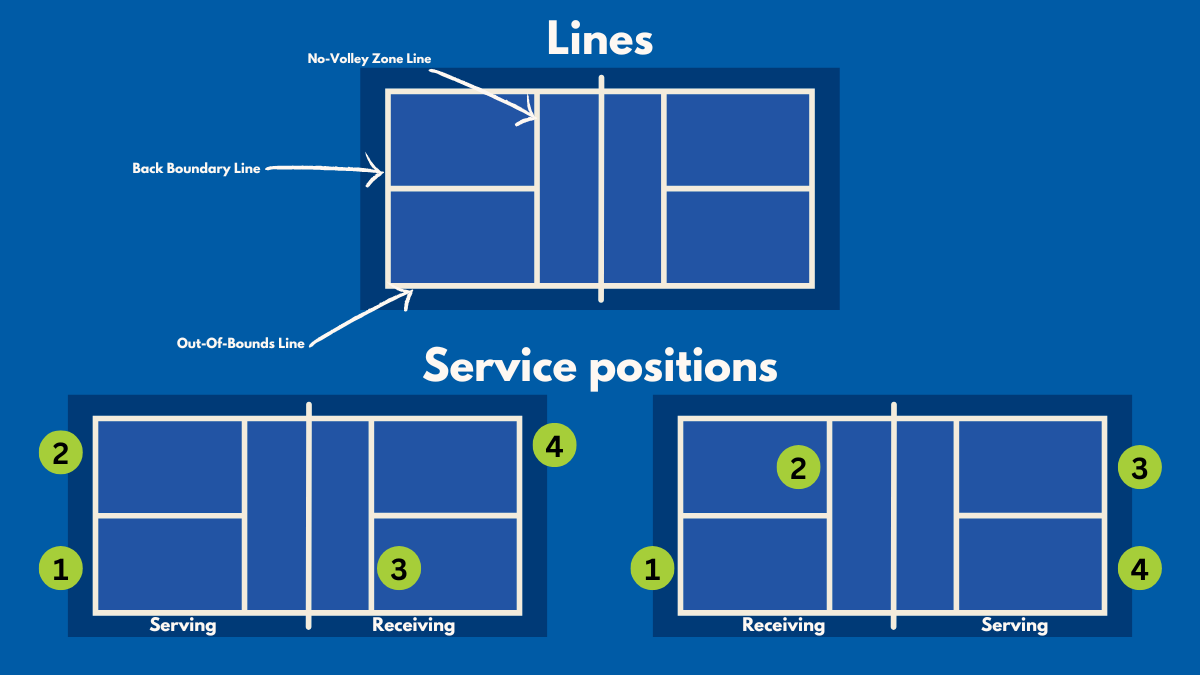
Non-Volley Zone (Kitchen)
The kitchen serves as a focal point for many pickleball strategies. Effective positioning in this area can significantly influence game outcomes.
- Importance of Effective Positioning: Mastering the kitchen means being able to execute soft shots while making it difficult for your opponent to win points through aggressive volleys. Players should strive to get to the kitchen line quickly after serving or returning the serve.
- Key Strategies: Focus on dinking and strategic placement of shots. By practicing these techniques within the non-volley zone, players can effectively neutralize their opponents while generating scoring opportunities.
- Opponent’s Tactics: Positioning in the kitchen also requires players to anticipate their opponent’s tactics. If your opponent is strong at the net, you may need to alter your approach to create openings.
Effective positioning in the kitchen is crucial, as it allows players to control the pace of play and seize opportunities to win points.
Baseline Positioning
Positioning at the baseline is essential for both receiving serves and strategizing offensive plays.
- Serving Team Dynamics: The serving players typically stay behind the baseline to prepare for the return. In singles play, players should be ready to return serves while maintaining a position that allows them to access both sides of the court.
- Returning Team Roles: In doubles, the non-receiving player often positions themselves in the kitchen while the receiving player stays back. This dynamic positioning enables quicker transitions depending on the rally’s development.
- Radial Positioning: Maintaining a balanced position on the baseline allows players to react effectively to opponents’ shots. Notice that players should also be ready to adjust, especially when foes execute lobs or deep shots.
Baseline positioning provides the fundamental ground from which tactical insight, controlled aggression, and effective defensive responses can be deployed.
Mid-Court Dynamics
Movement and positioning in the mid-court area are critical for maintaining balance and dictating the flow of a rally.
- Balanced Stance: Players should ideally maintain an athletic stance, remaining poised to react in any direction. This balance is key for quick movements, footwork, and adjustments during rallies.
- Anticipation Skills: The ability to read your opponent’s body language and shot trajectories can enhance mid-court positioning. Players must practice anticipating incoming shots to ensure they’re well positioned to respond effectively.
- Side-to-Side Movement: In mid-court, lateral movements are crucial for effective coverage. Players who can shift quickly (using crossover steps or split steps) position themselves advantageously against the ball.
Mastering mid-court dynamics empowers players to create scoring opportunities while also defending against their opponents.
Positioning for Different Player Styles
Recognizing and adapting to different playing styles is integral to effective positioning.
- Aggressive Players: Players known for aggressive, net-focused gameplay might assume more upfront positioning, seeking to control the non-volley zone as early as possible. Strategies against them include keeping distance and mastering soft shots to neutralize their efforts.
- Defensive Players: Conversely, more defensive players may prefer staying further back near the baseline to absorb shots and utilize the full court. Positioning against such players requires patience and adaptability, implementing varied shot placements to draw them forward.
- Communication in Doubles: In doubles, understanding each partner’s style and playing strengths is vital. This mutual awareness fosters effective court coverage, enabling seamless plays that capitalize on both players’ strengths.
By adapting positioning strategies based on playing styles, players can develop a tactical edge and, consequently, elevate performance.
Strategic Positioning Techniques
Positioning in pickleball involves not only understanding the court layout but also implementing strategic techniques to enhance play. These techniques include approaches to the net, defensive vs. offensive positioning, communication with partners, and anticipation of opponents’ movements.
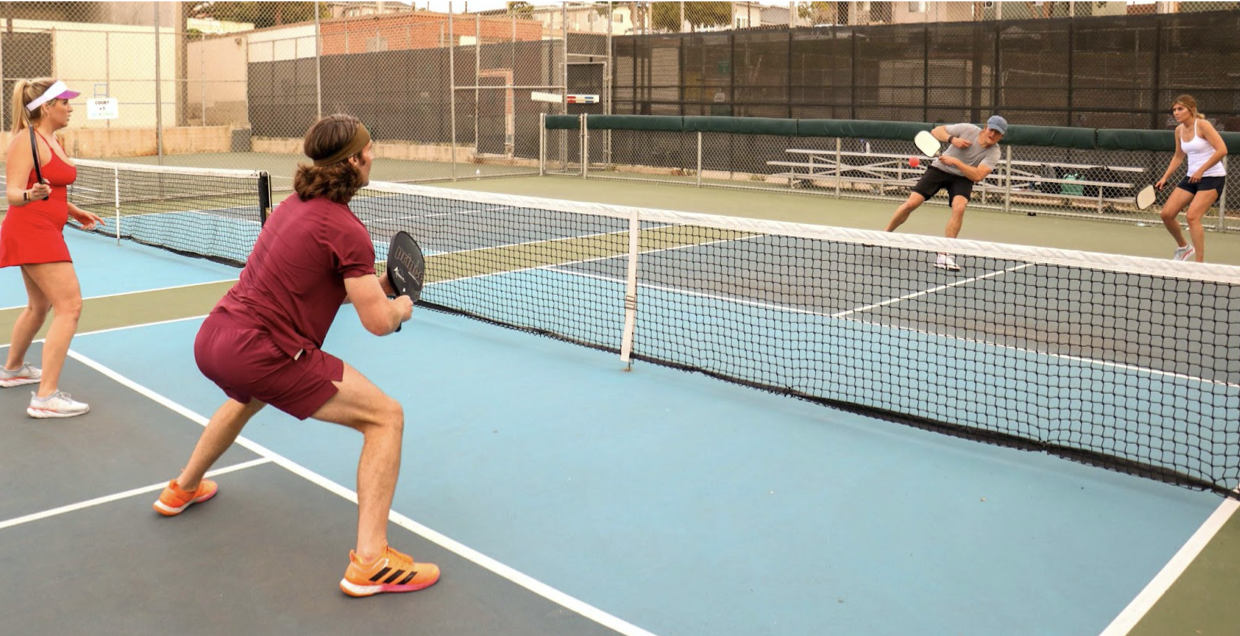
Approaching the Net
Approaching the net is a critical technique that dictates much of pickleball’s strategic flow.
- Aggressive Positioning: Players should adopt an assertive stance when approaching the net, keeping their feet active and their stance low. This readiness allows players to respond quickly to any ball their opponents may hit.
- Utilizing Offensive Shots: When near the net, players can utilize volleys, soft shots, and dinks, effectively maintaining pressure and keeping opponents on their toes.
- Anticipate Opponent’s Responses: As players approach, it’s essential to anticipate how opponents will react and adjust positioning accordingly. If opponents seem ready to lob, positioning to counteract this tactic may prevent loss of control.
Approaching the net well can significantly impact the outcome of a rally and is a hallmark of an excellent pickleball player.
Defensive vs. Offensive Positions
Understanding the distinction between defensive and offensive positions can greatly affect gameplay.
- Defensive Positioning: When in a defensive position, the objective shifts to maintaining court coverage while preparing for incoming shots. Players often position themselves more towards the baseline, ensuring they can respond effectively to deep shots or lobs.
- Offensive Positioning: In contrast, offensive settings occur when players engage at the kitchen line, actively working to dictate play dynamics. Here, players utilize hard shots and quick volleys to assume control and pressurize their opponents.
- Situational Awareness: The transition between the two positions requires acute situational awareness and the ability to recognize shifts in rallies. Effective communication with partners enhances this adaptive strategy.
Players who understand how to navigate between defensive and offensive positioning gain a significant competitive edge.
Communicating with Your Partner
Communication remains a linchpin for successful court positioning, especially in doubles play.
- Clear Verbal Cues: Establishing a set of verbal cues, such as “mine” or “yours,” helps clarify roles and responsibilities during rallies, enabling players to avoid confusion.
- Non-Verbal Signals: In addition to vocal communication, developing hand signals can enhance coordination, especially when verbal cues may not be practical.
- Strategy Coordination: Discussing strategies pre-match and adjusting on the fly helps both players maintain synchronized positioning. Open dialogue fosters mutual understanding and ensures players are well-positioned to execute plays.
Strong communication promotes teamwork, reduces the likelihood of errors, and enhances overall court coverage.
Anticipating Opponent’s Moves
Anticipating your opponent’s actions can have a profound impact on your positioning strategy.
- Reading Body Language: Observing subtle cues like changes in body language, racket positioning, or shot preparation allows players to predict opponent actions and adjust their positioning accordingly.
- Shot Pattern Recognition: Identifying patterns in an opponent’s play helps determine likely shot selections. For instance, if an opponent frequently utilizes their backhand, adjusting position to counter this play increases the chances for successful defense.
- Practice Court Awareness: Regular drills and practice games focused on reading and anticipating an opponent’s moves can enhance your overall game strategy and response time.
Continuous practice in reading opponents is a vital skill that can set a player apart from their rivals.
Doubles Positioning Strategies
In doubles, understanding the intricacies of positioning becomes critical for maximizing court coverage and efficiency. Players must navigate positions that complement each other while adapting to their opponents.

The Two-Up Formation
The two-up formation places both players at the non-volley zone line, enhancing offensive pressure on opponents.
- Enhanced Control of the Net: By positioning at the net, both players can readily execute volleys and pressure the opposing team, often leading to a higher rate of unreturned serves.
- Intensified Communication: Success in this formation hinges on effective communication. Both players must be acutely aware of their positioning and strategize where to cover based on the flow of play.
- Adaptability: Quick adaptability within this formation allows for seamless transitions back to the baseline if required, creating tactical flexibility.
The two-up formation is favored for its aggressive approach, fostering a high-pressure environment for opponents.
The One-Up, One-Back Strategy
The one-up, one-back strategy integrates balance by positioning one player at the kitchen line and the other near the baseline.
- Balanced Coverage: In this alignment, the front player can control the net while the back player provides additional coverage for lobs and deep shots, ensuring both offensive and defensive capabilities.
- Positioning for Offensive Plays: The front player maintains pressure while having the back player set up for potential offensive shots to follow.
- Transitioning Roles: One vital aspect of this strategy lies in effectively transitioning roles based on the rally’s development. Quick adaptation prevents both players from being caught out of position.
The one-up, one-back strategy enables teams to achieve a balanced gameplay approach while expressing adaptability based on opponents’ movements.
Managing Court Coverage
Effective court coverage in doubles requires careful management of each player’s positioning.
- Cooperation and Coordination: Both players must consistently communicate and coordinate their movements to avoid overlaps and mistakes. They must also be aware of where the ball is located to prevent gaps in coverage.
- Responding to Opponent’s Moves: Each player’s positioning should be responsive to the opponents’ shots. Adjusting positioning based on the ball’s trajectory mitigates the risk of leaving court areas exposed.
- Controlled Aggression: Positioning for controlled aggression enables players to dictate the pace while maintaining defensive integrity, ensuring all areas of the court are covered.
Efficient court coverage necessitates cooperation and awareness from both players, shaping successful doubles play.
Adjusting to Opponent’s Tactics
Adapting one’s positioning strategy based on opponent movements is vital for tactical success.
- Recognizing Patterns: Players should observe and identify any recurring patterns in their opponents’ gameplay. Is the opponent dominant at the net? Do they prefer powerful backhands?
- Communicating Adjustments: If you identify weaknesses in your opponent’s tactics, promptly communicate with your partner to adjust positioning accordingly.
- Flexibility in Positioning: An adaptable approach allows players to modify their tactics mid-game, keeping opponents off-balance.
Being able to adjust to opponents’ tactics can change the trajectory of matches and secure wins.
Singles Positioning Tactics
Positioning in singles play requires a different approach from doubles, focusing primarily on individual performance, space management, and tactical execution.

Maintaining Center Position
A vital tactic in singles pickleball is maintaining a central position on the court.
- Efficient Coverage: By staying near the centerline and transitioning between sides, players can maximize their reach and respond effectively to shots. This positioning allows players to move laterally, maintaining balance and readiness.
- Reacting in Time: A centered stance ensures quicker reactions to opponents’ shots, enabling agile movement towards any corner of the court.
- Consistent Pressure: Maintaining a central position can create an additional psychological edge over opponents, keeping them guessing about shot placements.
Center positioning in singles play is essential for maximizing reaction time and strategic flexibility.
Transitioning from Defense to Offense
Transitioning smoothly from a defensive position to an offensive stance can turn the tide during rallies.
- Recognizing Opportunities: Players must develop a keen eye for recognizing when the rally can shift in their favor, such as after receiving a weak shot or when the opponent reaches a vulnerable position.
- Using Defensive Shots: Utilizing defensive shots like lobs creates an opportunity to reposition near the non-volley zone, regaining control of the point.
- Seizing Momentum: Once a player transitions back to offense, executing aggressive shots allows for regained momentum, creating scores and dictating the game’s pace.
Effective transitions can create scoring opportunities while facilitating a shift from defense to offense.
Utilizing the Baseline
Positioning near the baseline offers strategic advantages, especially for defensive play.
- Time for Reaction: Retreating to the baseline provides players the time and space to evaluate their opponent’s shots effectively while allowing for greater shot selections.
- Absorbing Incoming Shots: From the baseline, players can absorb and control shots before moving into an offensive position closer to the kitchen.
- Strategic Power Shots: Utilizing this area enables players to execute powerful returns, challenging their opponents and creating openings for offensive plays.
Utilizing the baseline strategically cultivates a robust defensive posture while allowing for transitions back into an offensive position.
Exploiting Opponent’s Weaknesses
In singles play, exploiting an opponent’s weaknesses is essential to achieving victory.
- Identifying Weaknesses: Observing an opponent’s movements, shot abilities, and preferred sides allows for targeted strategies. If an opponent struggles with backhands, consistent targeting of that side may yield favorable results.
- Varying Shot Types: Using a variety of shots including deep serves to push opponents back, followed by drop shots to move them forward creates an uncomfortable situation for opponents.
- Maintaining Pressure: Consistently placing shots into your opponent’s weaker areas keeps them off-balance and unable to mount a strong offensive.
Mastering the exploitation of opponents’ weaknesses significantly bolsters scoring opportunities in singles matches.
Enhancing Court Awareness
Enhancing court awareness involves understanding how to navigate the pickleball court effectively while adapting positioning strategies throughout the game.
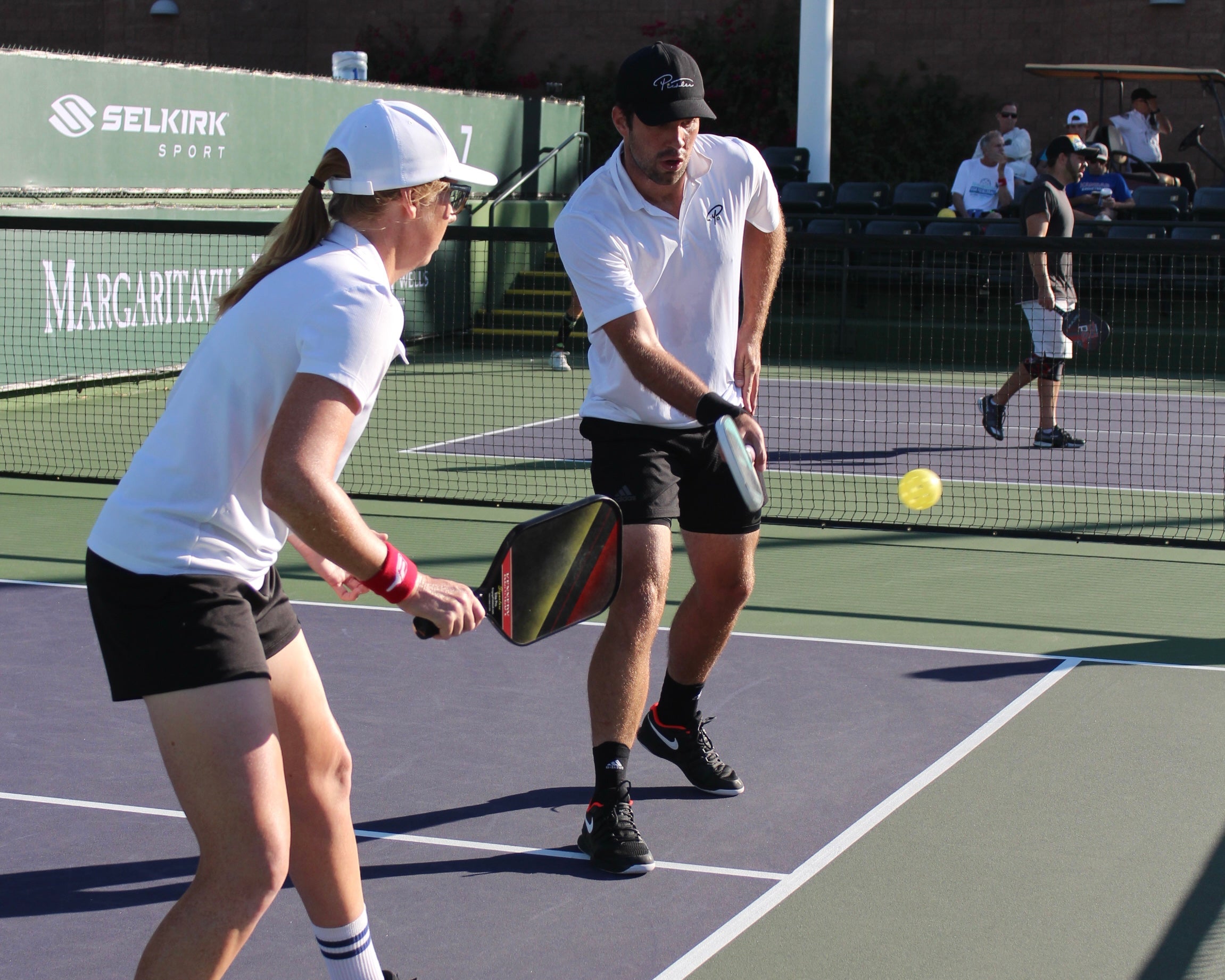
Visual Cues for Positioning
Utilizing visual cues can sharpen court awareness while enhancing positional techniques.
- Observing Opponent’s Body Language: Players should learn to read subtle changes in body language that precede shots, allowing them to position themselves effectively.
- Tracking Ball Trajectories: Understanding where the ball is heading assists in determining necessary movements or adjustments.
- Analyzing Court Layout: Maintaining a mental picture of the court layout helps anticipate where to stand based on the rallies’ context.
Sharpening awareness through visual cues facilitates improved positioning throughout gameplay.
Tracking Opponent Movement
Monitoring an opponent’s movement is crucial for timely positioning and anticipating their next move.
- Behavior Recognition: Recognizing an opponent’s tendencies regarding their approach to the ball allows for preemptive positioning.
- Adjusting Based on Movements: Players must be observant and adapt their positioning strategies based on opponents’ movements during rallies.
- Creating Opportunities: Tracking your opponent’s shifts can create gaps in coverage, allowing players to exploit openings for a strategic advantage.
Effectively tracking opponents enhances one’s ability to adjust positioning dynamically.
Adjusting to Game Flow
Adapting positioning based on the flow of the game can impact success dramatically.
- Resilience in Strategy: Players should remain flexible and resilient, adjusting their positioning to align with current strategies as rally dynamics change.
- Reading the Game: Understanding when to play aggressively or defensively requires continuous assessment of not just one’s own positioning but also that of the opponent.
- Synchronizing Movements: Ensuring movement aligns with the game’s flow promotes seamless play and prevents being caught out of position.
Adjusting to the evolving dynamics of the game serves as a vital asset during competitive play.
Reacting Quickly to Shots
Quick reactions can make or break a rally in pickleball, emphasizing the importance of agility and responsiveness.
- Athletic Stance Maintenance: Keeping a ready athletic stance allows for instantaneous movements and dynamic court coverage.
- Movement Drills: Practice drills focused on lateral movements and quick acceleration can enhance reaction times significantly.
- Mental Preparedness: Maintaining mental focus during matches prepares players to respond quickly to unexpected shots or strategies.
Quick reactions pave the way for effective positioning and can shift momentum in matches.
Practicing Positioning Drills
Practicing specific drills dedicated to improving positioning is critical for developing coordination and effectiveness on the court.
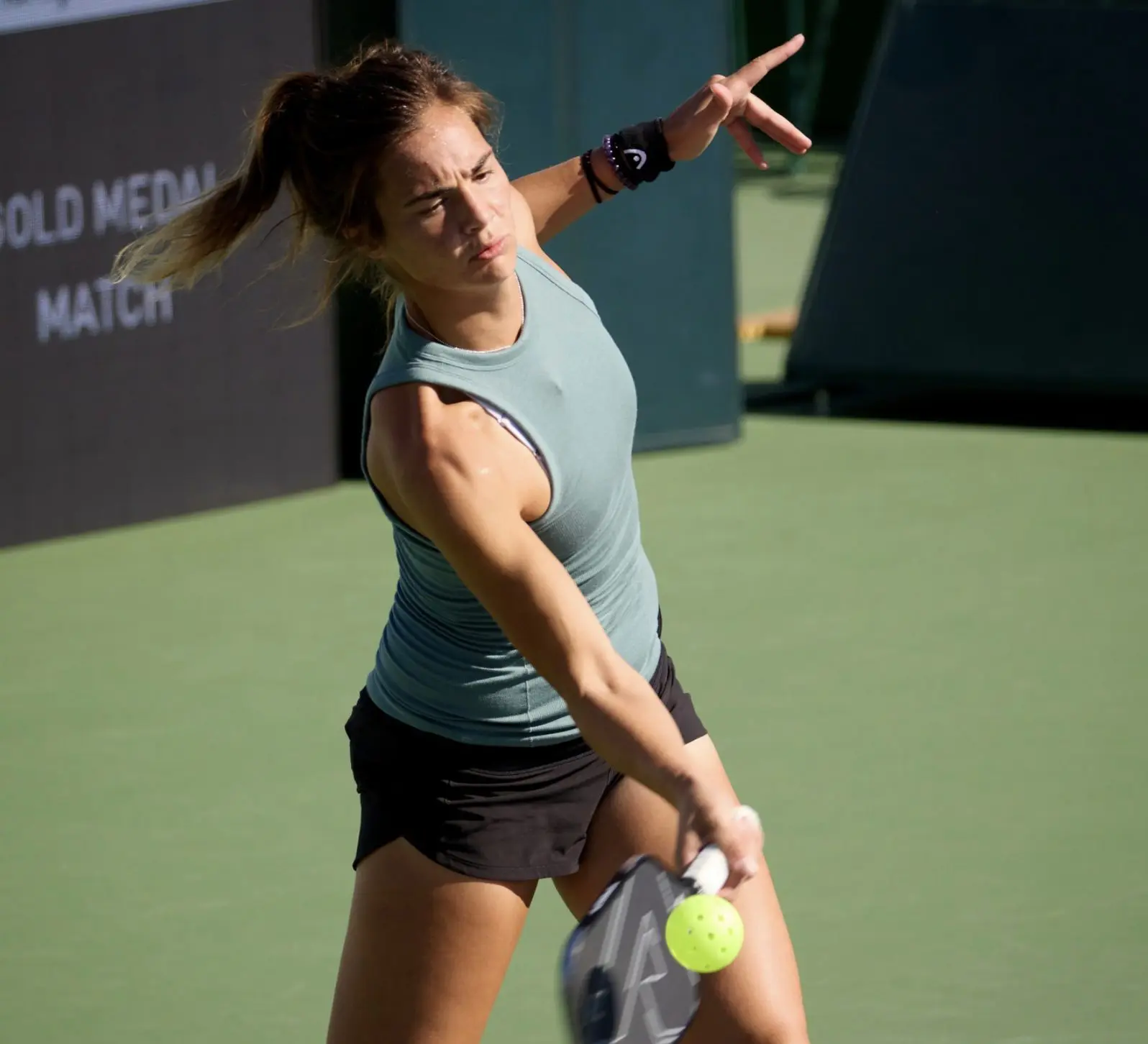
Essential Drills for Court Coverage
Several essential drills can help players maximize their court coverage:
- Lateral Movement Drills: Practice lateral shuffles along the baseline to enhance side-to-side movement and positioning.
- Split-Step Drills: Work on the split-step technique to improve readiness and reaction to incoming shots.
- Footwork Patterns: Incorporate various footwork patterns to facilitate efficient movement around the court, from forward and backward to lateral movements.
Regular drills focused on these aspects solidify foundational skills vital for effective positioning.
Partner-Based Positioning Drills
Partner drills encourage teamwork and improve awareness:
- One-Up, One-Back Drill: Practice proper positioning by alternating between one player at the net and the other at the baseline. Coordination is essential to maintain coverage.
- Lob Coverage Drill: Work on communication and movement to cover lob shots effectively, reinforcing teamwork during play.
- Dinking Drill: Engage in dinking drills with a partner, focusing on court positioning while keeping the dialogue open regarding shot strategies.
These drills build awareness and teamwork, which are integral for doubles play.
Solo Drills to Improve Awareness
Players can also enhance their positioning skills through solo drills:
- Wall Dinks: Perform soft dinks against a wall, concentrating on maintaining a ready position and efficient footwork.
- Shadow Swings: Practice swing mechanics and footwork without a ball to build muscle memory.
- Serve and Return Practices: Work independently on positioning for serving and returning serves, where proper foot placement is crucial.
Incorporating solo drills fosters skill development and reinforces foundational techniques.
Incorporating Positioning into Game Play
Once drills are solidified, translating practice into game situations is vital:
- Simulating Game Scenarios: Use a ball machine or wall to practice shots and positioning as if engaged in real matches.
- Imaginary Opponent: Visualize an opponent during practice to develop tactical responses based on anticipated shots and positioning.
- Communication Focus: Emphasize communication and coordination with partners during actual gameplay to strengthen teamwork.
Effective transitions from drills to real matches ensure enhanced positioning skills reflectively.
Common Positioning Mistakes
Navigating the intricacies of pickleball positioning can often lead to common mistakes, highlighting the importance of continuous practice and learning.
Misjudging Court Boundaries
Players frequently misjudge court boundaries due to unfamiliarity or lack of spatial awareness.
- Boundary Awareness: Understanding the exact dimensions is crucial to avoid shot errors or fault calls during matches.
- Positioning Adjustments: Players should maintain a sense of spatial context, avoiding overly aggressive positions that risk stepping out of bounds.
Failing to grasp court boundaries can severely impact gameplay, making consistent practice essential.
Poor Communication with Partner
Communication breakdowns can be detrimental in doubles positions.
- Clear Signals and Cues: Establishing clear verbal and non-verbal signals aids in ensuring smooth movements and coverage.
- Overlap Scenarios: Players should aim to avoid overlapping responsibilities, fostering a more strategic partnership during matches.
Consistent communication boosts teamwork while minimizing mistakes in coverage.
Failing to Anticipate Shots
Not effectively anticipating shots can lead to unfavorable positioning and missed returns.
- Reading Opponents: Failing to observe opponents leaves players vulnerable during rallies, often caught out of position.
- Odds of Reaction: Players who don’t practice recognition skills may struggle with quick shots, prompting missed returns.
Developing the ability to read and anticipate opponents is vital for maintaining strategic positioning.
Overcommitting to Offense or Defense
Balance is critical; overcommitting to either offense or defense can lead to substantial tactical errors.
- Defensive Vulnerability: Players too focused on offense may leave themselves prone to defensive lapses, exposing themselves to lobs or counter-attacks.
- Offensive Stagnation: Conversely, excessive defensive positioning can lead to lost opportunities for aggressive plays, missing chances to control the court.
Striving for balance while adjusting to the dynamics of a match is crucial for effective positioning.
Advanced Positioning Concepts
As players advance, understanding complex positioning concepts becomes essential for success in competitive play.
Incorporating Footwork into Positioning
Footwork is crucial for effective positioning across all levels of pickleball.
- Various Footwork Techniques: Players must master footwork techniques split steps, lateral movements, and transitions for seamless movements around the court.
- Agility and Balance: Enhanced footwork promotes agility, enabling players to reposition quickly and regain balance during challenging plays.
Integrating effective footwork into positioning strategies lays the groundwork for advanced skills.
Adapting Positioning to Different Opponents
Adapting to different playing styles is critical for success.
- Observation Skills: Players should study the tendencies and strengths of their opponents and adjust positioning strategies accordingly.
- Adaptability: Successful players are those who can fluidly maneuver and readjust their positions and play styles, capitalizing on their opponents’ weaknesses.
Flexibility in positioning allows players to stay competitive in dynamic match scenarios.
Analyzing Positioning Post-Match
Post-match analysis empowers players to refine their positioning strategies.
- Connecting Data: Using tracking technologies enables players to review their court coverage, movement patterns, and shot selections critically.
- Identifying Areas for Improvement: Recognizing patterns and gaps in positioning allows the opportunity for corrective measures to be taken into future matches.
Adopting a post-match analytical approach enhances the learning curve for future gameplay.
Utilizing Technology for Positioning Insights
Leveraging technology can yield deeper insights into effective positioning strategies.
- Tracking Systems: Advanced player tracking systems capture data on shot locations and movements, yielding performance metrics and trends.
- Data Analysis: Utilizing insights from tracking technology can uncover weaknesses in positioning, allowing players to formulate adjustments.
Incorporating technology can equip players with the knowledge for improved positioning strategies and enhance overall gameplay.
FAQs
What is the positioning strategy in pickleball?
Positioning strategy in pickleball revolves around controlling the center of the court and executing plays from the non-volley zone. Players aim to maintain an advantageous position while anticipating opponents’ shots and coordinating movements with their partner.
How do you position yourself in pickleball?
Effective positioning encompasses various principles:
- Maintain a stance near the centerline for optimal court coverage.
- Stand at the baseline for serves and returns.
- Position yourself in the non-volley zone when at the net to maximize control.
- Adjust positioning throughout the game based on necessary shifts in strategy.
What positions are there in pickleball?
Key positions in pickleball include:
- Serving team positions: One player at the baseline, one at the kitchen line.
- Receiving team positions: One player at the baseline, one at the kitchen.
- Side-by-side or staggered positioning: Adaptive strategies based on partners’ strengths.
How do you improve your placement in pickleball?
Improving placement involves emphasizing strategic court positioning and movement through regular practice. Focus on maintaining a balanced stance, coordinating with partners in doubles, and anticipating your opponent’s movements.
What is the ideal attacking position in pickleball?
The optimal attacking position is at the non-volley zone (NVZ) line, where players can effectively execute volleys, dinks, and exert pressure on opponents.
Conclusion
Mastering pickleball positioning enhances the overall quality of play and contributes to success on the court. From understanding the court’s layout and key areas to practicing effective positioning strategies, every aspect cultivates a deeper comprehension of the game. By continuously refining your skills, engaging with your partner, and adapting to the dynamics of gameplay, you can elevate your pickleball experience to new heights. The art of positioning is not just a component of the game it is the very foundation upon which great players build their strategies, cultivate their strengths, and often, win their matches.
